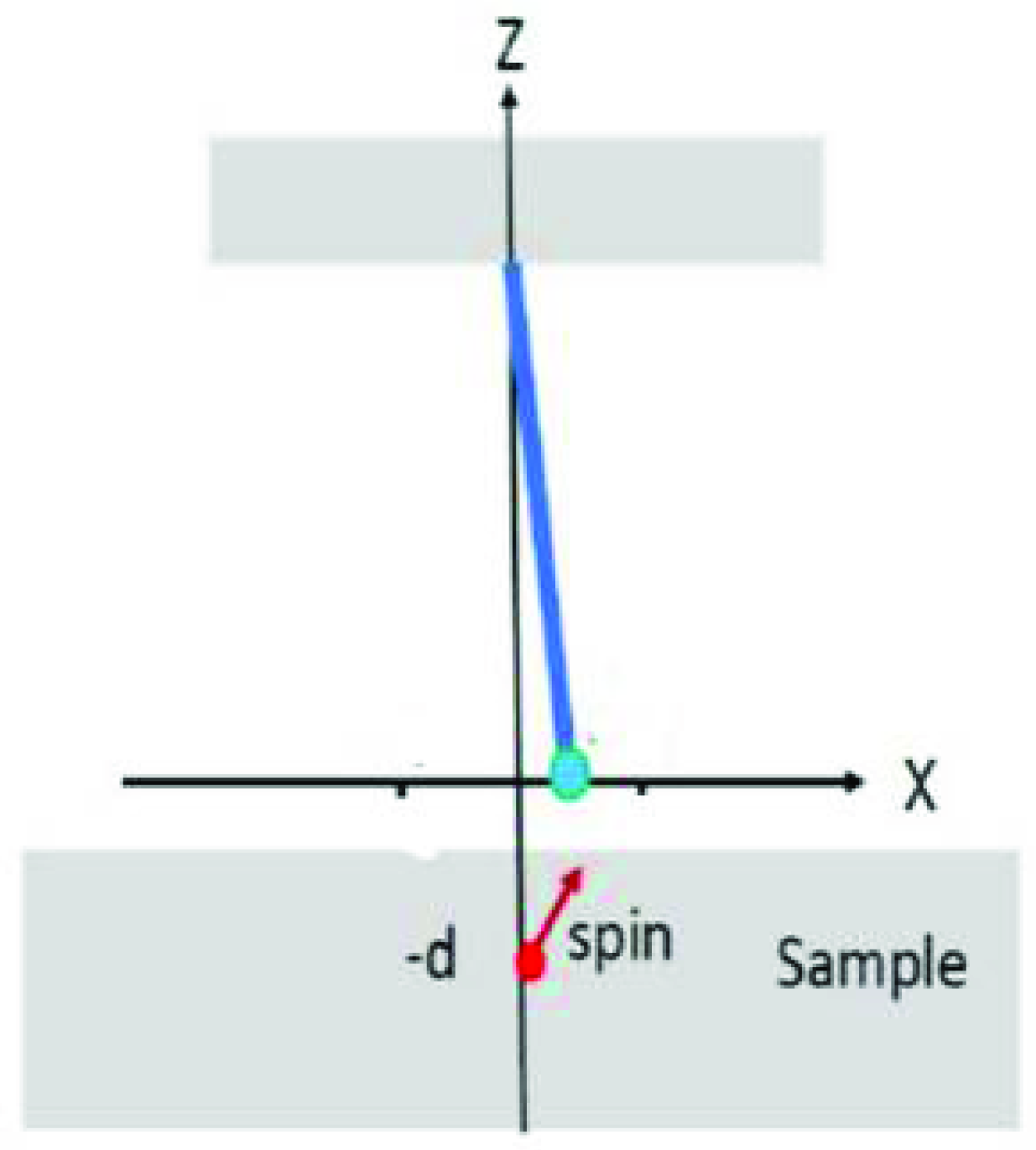A Qubit Represented by the Oscillator’s Quantum States in Magnetic Resonance Force Microscopy
Abstract
:1. Introduction
2. Results
3. Conclusions
Author Contributions
Funding
Institutional Review Board Statement
Informed Consent Statement
Data Availability Statement
Conflicts of Interest
References
- Sidles, J.A.; Garbini, J.L.; Bruland, K.J.; Rugar, D.; Züger, O.; Hoen, S.; Yannoni, C.S. Magnetic resonance force microscopy. Rev. Mod. Phys. 1995, 67, 249–265. [Google Scholar] [CrossRef]
- Rugar, D.; Budakian, R.; Mamin, H.J.; Chui, B.W. Single spin detection by magnetic resonance force microscopy. Nature 2004, 430, 329–332. [Google Scholar] [CrossRef] [PubMed]
- Berman, G.P.; Borgonovi, F.; Gorshkov, V.N.; Tsifrinovich, V.I. Magnetic Resonance Force Microscopy and a Single-Spin Measurement; World Scientific: Singapore, 2006. [Google Scholar]
- Obukhov, Y.; Pelekhov, D.V.; Kim, J.; Banerjee, P.; Martin, I.; Nazaretski, E.; Movshovich, R.; An, S.; Gramila, T.J.; Batra, S.; et al. Local Ferromagnetic Resonance Imaging with Magnetic Resonance Force Microscopy. Phys. Rev. Lett. 2008, 100, 197601–197605. [Google Scholar] [CrossRef] [PubMed]
- Grob, U.; Krass, M.D.; Héritier, M.; Pachlatko, R.; Rhensius, J.; Košata, J.; Moores, B.A.; Takahashi, H.; Eichler, A.; Degen, C.L. Magnetic Resonance Force Microscopy with a One-Dimensional Resolution of 0.9 Nanometers. Nano Lett. 2019, 19, 7935–7940. [Google Scholar] [CrossRef] [PubMed] [Green Version]
- Mo, L.; Tang, H.X.; Roukes, M.L. Ultra-sensitive NEMS-based cantilevers for sensing, scanned probe and very high-frequency applications. Nat. Nanotechnol. 2007, 2, 114–120. [Google Scholar]
- Doolin, C.; Kim, P.H.; Hauer, B.D.; MacDonald, A.J.R.; Davis, J.P. Multidimensional optomechanical cantilevers for high-frequency force sensing. New J. Phys. 2014, 16, 035001–035013. [Google Scholar] [CrossRef]
- Tang, C.; Alici, G.J. Evaluation of length-scale effects for mechanical behavior of micro- and nanocantilevers: I. Experimental determination of length-scale factors. J. Phys. D Appl. Phys. 2011, 44, 335501–335502. [Google Scholar] [CrossRef]
- Kolhatkar, A.G.; Jamison, A.C.; Litvinov, D.; Willson, R.C.; Lee, T.R. Tuning the Magnetic Properties of Nanoparticles. Int. J. Mol. Sci. 2013, 14, 15977–16009. [Google Scholar] [CrossRef] [PubMed] [Green Version]
- Berman, G.P.; Gorshkov, V.N.; Tsifrinovich, V.I. Electron Spin Relaxation Induced by a Cantilever when the Spin Frequency Matches the Cantilever Frequency. J. Appl. Phys. 2021, 130, 144402–144407. [Google Scholar] [CrossRef]
- Berman, G.P.; Tsifrinovich, V.I. Magnetic Resonance Force Microscopy with Matching Frequencies of Cantilever and Spin. J. Appl. Phys. 2022, 131, 044301. [Google Scholar] [CrossRef]
- Jaynes, E.T.; Cummings, F.W. Comparison of quantum and semiclassical radiation theories with application to the beam maser. Proc. IEEE 1963, 51, 89–109. [Google Scholar] [CrossRef] [Green Version]
- Stenholm, S. Quantum theory of electromagnetic fields interacting with atoms and molecules. Phys. Rep. Sect. C Phys. Lett. 1973, 6, 1–121. [Google Scholar] [CrossRef]

Publisher’s Note: MDPI stays neutral with regard to jurisdictional claims in published maps and institutional affiliations. |
© 2022 by the authors. Licensee MDPI, Basel, Switzerland. This article is an open access article distributed under the terms and conditions of the Creative Commons Attribution (CC BY) license (https://creativecommons.org/licenses/by/4.0/).
Share and Cite
Christou, P.; Tsifrinovich, V.I. A Qubit Represented by the Oscillator’s Quantum States in Magnetic Resonance Force Microscopy. Magnetochemistry 2022, 8, 76. https://doi.org/10.3390/magnetochemistry8080076
Christou P, Tsifrinovich VI. A Qubit Represented by the Oscillator’s Quantum States in Magnetic Resonance Force Microscopy. Magnetochemistry. 2022; 8(8):76. https://doi.org/10.3390/magnetochemistry8080076
Chicago/Turabian StyleChristou, Panayiotis, and Vladimir I. Tsifrinovich. 2022. "A Qubit Represented by the Oscillator’s Quantum States in Magnetic Resonance Force Microscopy" Magnetochemistry 8, no. 8: 76. https://doi.org/10.3390/magnetochemistry8080076
APA StyleChristou, P., & Tsifrinovich, V. I. (2022). A Qubit Represented by the Oscillator’s Quantum States in Magnetic Resonance Force Microscopy. Magnetochemistry, 8(8), 76. https://doi.org/10.3390/magnetochemistry8080076






